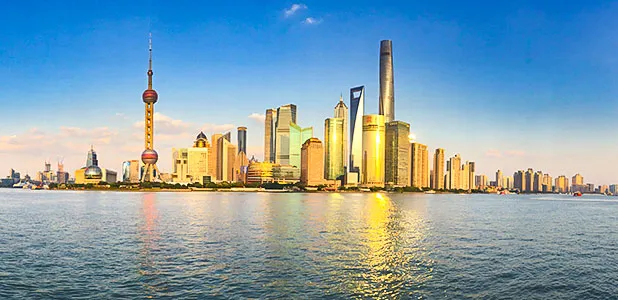Home /
Top 10 Largest Cities in China by Population
China has over 600 cities and a population exceeding 1,400 million. Since about 260 million Chinese people live in just 15 cities, it will be more appropriate to use the totals of permanent residents as a criterion to define city scale. Then, there comes 19 supercities, each with more than 5 million people, and 3 megacities, each with more than 20 million people. These are Chongqing, Shanghai, Beijing, Chengdu, Tianjin, Guangzhou, Shenzhen, Wuhan, Harbin and Suzhou…
Details of top 10 largest cities in China by population are given below:
1
Chongqing – 31.2 Million People
Geographical location is the first reason why Chongqing is the biggest city in China by population. As a transport hub connecting all four points of the compass, this city evolved as a popular destination for internal migration. Secondly, as the sole municipality and largest city in western China, Chongqing enjoys long-standing favorable policies for developing industry and commerce, enabling many job opportunities that attract outsiders to move in. Also, a historical factor should be considered. During the Sino-Japanese War (1931-1945), almost one million people sought shelter here, laying a base for this city’s future expansion.
2
Shanghai – 24.3 Million People
Many think that Shanghai is the largest city in China. In fact, it is the second largest city in China by population and major economic center. During its development, location has contributed greatly. Situated at the Yangtze River Delta, Shanghai has been a busy trading port and a desired location for international corporations ever since the 19th century. Plus, following the development of Pudong Airport and Hongqiao Airport, Shanghai has become a truly international metropolis fueled by information technology, new energy industry, a futures and bonds market, and wholesale and retail industry. There is every inducement for people to settle here.
3
Beijing – 21.5 Million People
Which is the largest city in China? Many people will blurt out the capital, Beijing. It is worth mentioning that when it comes to population, Beijing is ranked as the third largest city in China. Nevertheless, no one can deny its importance in this country. On the one hand, with more than 3,000 years’ history and over 1,000 years’ history as capital, Beijing boasts political supremacy and a profound culture. On the other hand, Beijing plays an increasingly leading role in finance and technology. They together attract locals and outsiders to stay. Thanks to its excellent airports, railways and metro lines, individuals and companies alike, both domestic and foreign, benefit from the easy access to this megacity.
4
Chengdu – 16.6 Million People
Chengdu, the 4th largest city in China in terms of permanent residents, is the capital city of Sichuan Province, southwestern China. Since this place is endowed with plain-lands, numerous rivers and a pleasant climate, the ancient Chinese considered it the Land of Abundance as they developed agriculture. Progress in industry and commerce had also been made during the Tang and Song Dynasties (618-1279). Even today, whenever a large corporation wants to set up headquarters in southwestern China, Chengdu is always the first choice. Accordingly, more and more people move here to pursue a promising career. In addition, as a tourism city, Chengdu wins many people’s affection for its cultural relics, Sichuan cuisine, cute panda and slow-paced life. No wonder many tourists, even those from overseas, decide to live here after their visit.
5
Tianjin – 15.6 Million People
One of the most important reasons placing Tianjin among the top 5 largest cities in China is its location. East of the Bohai Sea, Tianjin is the very center of the Bohai Economic Rim and the biggest port city in northern China. In fact, this place already took advantage of its position and started transporting goods back in the Tang Dynasty (618-907 AD). In 1860, it was officially designated as a trading port by the Qing government. Ever since then, Tianjin has played a crucially important role in handling imports and exports with overseas countries. Tianjin’s economic prosperity and expansion can also be attributed to its airway, highway and railway construction.
6
Guangzhou – 15.3 Million People
By no means can Guangzhou be omitted from the list of largest cities in China. Located at the Pearl River Delta and connecting Hong Kong, Macau, Shenzhen, Dongguan and other cities in southern China, this capital city of Guangdong Province exerts its political and economic influence to the full. More importantly, the Guangzhou Port and Baiyun International Airport with their excellent handling capacity bring in many business opportunities from other countries. China’s Import and Export Commodity Fair is held here every year, luring potential partners and investment from Fortune 500 corporations. The amassment of young talents also spurs its high-tech industry. Profound history, convenient transportation and creative atmosphere together make Guangzhou a competitive and desirable first-tier city.
7
Shenzhen – 13.4 Million People
In 1980, under the reform and opening up policy, Shenzhen was appointed as a special economic zone in southern China for its favorable location. Thanks to this policy, Shenzhen rapidly developed from being a fishing village to an emerging city of immigrants in just 40 years. Now, Shenzhen benefits from the advanced Bao’an International Airport, 15 entry and exit ports (the most in China) and four major railway stations, serving 13.4 million residents. As you can imagine, it is the inclusiveness and creativity that enabled Shenzhen to make giant strides in high-tech industry, financial services, export trading and creative culture. Now, from the perspective of GDP, Shenzhen ranks among the four largest cities in China together with Beijing, Shanghai, and Guangzhou; and this China’s large city is playing an exemplary role in administrative system innovation and opening up to the world.
8
Wuhan – 11.2 Million People
Wuhan, capital of Hubei Province, is an important industrial base in central China. Its history as a military and commercial stronghold dates back to the Spring and Autumn Period (770-476 BC). It was also a political and cultural center in modern China.
Nevertheless, the primary reason that makes it one of the 10 largest cities in China is its exceedingly extensive transport network. Since the Yangtze River and its biggest branch, the Han River, converge in Wuhan, Wuhan is blessed with favorable shipping conditions in the middle reaches of the Yangtze River. Moreover, the railway arteries that radiate from Wuhan, Wuchang and Hankou Railway Stations encompass more than half of China, making this city the biggest inland transportation hub. As a result, Wuhan gains its competitive edge mostly from secondary industry, including iron and steel, automobile manufacture, chemistry, metallurgy and shipbuilding.
9
Harbin – 10.8 Million People
Harbin is on the list of China’s largest cities by population for both natural and historical reasons. Long ago, the ancient Chinese found the black soil here extremely fertile, and gathered here to develop agriculture. During the 19th century, many inland Chinese suffered greatly from the frequent floods along the Yellow River and had to flee to the northeastern area to make a living, dramatically increasing the Harbin population. Now, compared with other provincial capitals, Harbin has lower commodity price and less living pressure, which attract those who value the quality of life. Besides, owing to the advanced railway construction, many Russian and European people consider it a nice foothold to develop cross-border trade.
10
Suzhou – 10.75 Million People
Suzhou is one of the core cities at the Yangtze River Delta in eastern China. Blessed with fertile soil and abundant rainfall, Suzhou has a long history of producing rice, wheat, cotton, silk and aquatic products, so it was capable of feeding more people in nature. Speaking of economy, Suzhou’s neighbor, Shanghai, is worth mentioning. Since these two largest cities in China are remarkably close to each other, Suzhou is galvanized considerably by Shanghai’s development. With the convenience brought by the airport and railway construction, more and more overseas-funded corporations favor Suzhou, bringing many job opportunities that attract people to move here. Information technology, biomedical technology, nanotechnology and artificial intelligence are now the city's top four up and coming industries.
You May Like
- Last updated on Aug. 06, 2025 by Gabby Li -



